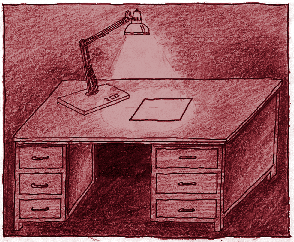Adjustable Task Lights
Task lights are fixtures that can be placed near, directly adjacent to, or above an area needing relatively high light levels. Task lighting is an efficient way to provide high light levels on reading materials or similar difficult-to-see objects. It is especially important to select a task light that does not provide a direct view of the light bulb. It is equally important to place the task light in a position where the person does not see a reflection of the light bulb in the task (e.g., on a computer screen).
The principles of task lighting can be applied in every space of the home (or workplace). Task lights can include one of a variety of light bulbs, including linear fluorescent, compact fluorescent, incandescent, or halogen. Task lights that plug into the wall include desk lamps, swing arm lamps, table lamps, and floor lamps.
- Place adjustable desk lamps, floor lamps, and table lamps as close to the working area as possible to get the highest light level on the visual task.
- Place the task light on the left side and slightly to the front if the person is right-handed. Place it to the right and slightly forward if the person is left-handed. This will reduce shadows cast by hands on paper, a cutting board, or other task surfaces.
- Place the task light beside the task, not in front of it, to avoid reflected glare from shiny surfaces like polished wood or glossy magazines.
- When upper cabinets are used in the kitchen or at a desk, light the work surface with thin undercabinet lighting fixtures mounted on the underside of the upper cabinets.
- For reading in bed, mount swing arm lamps above the head of the bed or to the side, below eye level.
The following matrix can help in the selection of a light bulb type and wattage for an adjustable-arm task light. The matrix provides approximate light levels (illuminances) at the center of the beam when the light source is located at different heights above the work surface. It should be noted that light levels decrease dramatically as the distance between the light source and the work surface increases. This matrix can also be used as a guide for selecting other types of light sources that might be applied in fixed positions (e.g., table lamps or undercabinet lighting fixtures).
In general, ambient light levels should be at least 300 lux (lx) or 30 footcandles (fc), and light levels on the task should be at least 1000 lx or 100 fc, to read or to see small or low-contrast objects. For more information on light levels for various visual tasks, look for the illuminance selection procedure table in the Illuminating Engineering Society of North America (IESNA) Lighting Handbook.
 |
| Light levels may very with fixture type. |
| Note: Compact fluorescent bulbs are generally cooler to touch than incandescent bulbs and they last longer. Choose a light bulb that is easy to change. |



